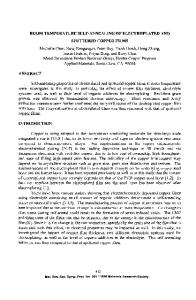Effect of passivation on stress relaxation in electroplated copper films
- PDF / 255,619 Bytes
- 7 Pages / 612 x 792 pts (letter) Page_size
- 21 Downloads / 342 Views
Yaoyu Pang and Rui Huanga) Department of Aerospace Engineering and Engineering Mechanics, University of Texas, Austin, Texas 78712
Jihperng Leu, Jose Maiz, and Tracey Scherban Intel Corporation, Hillsboro, Oregon 97214 (Received 5 January 2006; accepted 9 March 2006)
The present study investigated the effect of passivation on the kinetics of interfacial mass transport by measuring stress relaxation in electroplated Cu films with four different cap layers: SiN, SiC, SiCN, and a Co metal cap. Stress curves measured under thermal cycling showed different behaviors for the unpassivated and passivated Cu films, but were essentially indifferent for the films passivated with different cap layers. On the other hand, stress relaxation measured under an isothermal condition revealed clearly the effect of passivation, indicating that interface diffusion controls the kinetics of stress relaxation. The relaxation rates in the passivated Cu films were found to decrease in the order of SiC, SiCN, SiN, and metal caps. This correlates well with previous studies on the relationship between interfacial adhesion and electromigration. A kinetic model based on coupling of interface and grain-boundary diffusion was used to deduce the interface diffusivities and the corresponding activation energies.
I. INTRODUCTION
Copper (Cu) damascene structures with low k dielectrics are being implemented as on-chip interconnects to meet the demand for chip density and performance for 90 nm technology node and beyond. Recent studies on electromigration (EM) in the Cu interconnects have shown that mass transport is dominated by interface diffusion between Cu and the surrounding layers, especially at the interface subjected to chemical-mechanical polishing (CMP) and then passivated with a cap layer.1,2 This has generated great interest in improving EM reliability of Cu interconnects by optimizing the interface materials and processes to suppress the interfacial mass transport. Various cap layer materials and processing techniques have been proposed, and their effects on EM lifetime of Cu interconnects have been examined.3,4 In particular, Hu et al.3 demonstrated a significant improvement in the EM lifetime by coating the Cu surface with a thin metal layer, such as Pd and CoWP. However, it is difficult to delineate the kinetics of mass transport directly from the EM lifetime, which is controlled by the mechanism of
a)
Address all correspondence to this author. e-mail: [email protected] DOI: 10.1557/JMR.2006.0196 1512
http://journals.cambridge.org
J. Mater. Res., Vol. 21, No. 6, Jun 2006 Downloaded: 29 Mar 2015
damage formation, a complex process depending on local defects, microstructures, and the geometry of the interconnects. As interconnect scaling advances beyond the 90 nm node, the interface to volume ratio continues to increase with decreasing line width, making the interface an increasingly dominant path for mass transport during EM. Therefore, it is important to understand the effect of passivation on the kinetics of interfacial m
Data Loading...











